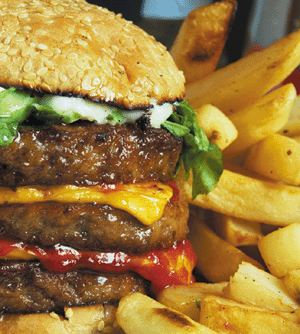
I focused my discussion on fast food in America and how the technology of the industry has negatively effected the human population and the environment. I used a selection of pages from Eric Schlosser’s Fast Food Nation to analyze the different sectors of the fast food nation. I attempted to compare the agriculture sector, the cattle sector, and the poultry sector and how they are affected by the improvement of technology in the fast food industry.
The birth of fast food occurred in Southern California. The characteristics of founders were similar in that they were all savvy, smart, business driven, and eventually grew large enough to own and control all levels of their operation. The majority of the men didn’t even graduate from high school but instead worked long enough to start their own business from scratch. Fast food founders used the increasing popularity of the automobile to their advantage by producing cheap, ready to eat, delicious food.
Most of the fast food founders began their businesses after working in agriculture. Most of the farms in the period were independent farms owned independently. At the time, the US government was providing huge subsidies to entice farmers out to the west to farm acres of land.
Unfortunately, over the period of time fast food has evolved, it has affected the industries it used to rely on; the evolution of fast food has shifted the ranching and meat industries to become dependent on the fast food corporations. This shift has moved from independent farms to a relationship that resembles sharecropping. Farmers and ranchers are forced to produce large yields for very small amount of money. Because each little additional yield means a little more profit, they get tied into the fallacy of composition. This is where farmers and ranchers are forced to adopt a new technology after another to increase yields, year after year. This negatively affects the farmers and ranchers and causes them to be accountable to the fast food industry instead of vice versa.
Political developments also play a large role in assisting the large fast food nations to assume such a large role over the agriculture and meat industries. After the novel The Jungle, by Upton Sinclair, was published in 1906, the corruption of the meatpacking industries were revealed and there was great political change to increase not on working conditions but also to break down the large holdings that the meatpacking industry owners held. However, in 1970 the Sherman anti-trust acts that prohibited the monopolization of industries were removed by the Reagan administration. This allowed for the merging of many levels that involve the fast food industries into one company. Soon, four companies were able to merge with other smaller companies that they comprised 80% of the slaughtering industry.
This new method of organizing business allowed the company to control their product from start to finish. Cattle for example were known as captive supplies and were purchased through private owned contracts with smaller ranches. These farmers “grew” the cattle until it was time for them to be slaughtered. The cattle then are slaughtered and processed and then distributed throughout the nation.
The poultry industry developed similarly to the cattle industry. Once a cheap way was developed to raise chickens, they became more efficient to raise and slaughter than cattle. Poultry farms were focused in the south where the weather is mild and the labor is not unionized and cheap. The only role independent poultry farms played was to receive private contracts from the fast food companies to raise chickens. Private poultry farms are only responsible for the chickens until they are old enough to slaughter.
Another negative change resulting from the growth of the fast food industries is in the labor sectors. Most fast food companies focus on employing immigrants and non-unionized people. These people will work long hours for little pay. They also work in deplorable conditions that are very hazardous. There is also a high degree of harassment and little upward mobility for the workers.
Fast food also negatively affects those that consume it. Fast food is designed to taste good by containing high levels of salt and sugar. Many dishes are fried and contain more calories in one serving than are supposed to be consumed in an entire day. The evolutionary trait for humans to like the taste for fat and salt is harmful because humans are not actively burning off extra calories. Many children get hooked on fast food through this way; the advertising gimmicks also help tempt individuals in at a young age as well.
Fast food has also effected globalization. Around the world, McDonalds is universally recognized as American. McDonalds are US ambassadors in other nations; all America’s values and traditions are contained in one cardboard box. Globalization has also lead to the replication of degrading other nation’s workforces and industries the same as in the united states. The large quantities of waste are astronomical and also have negative effects on the environment.
Consumers ultimately have the power in the cycle. If consumers decide that the conditions and treatment of the other agents involved in producing fast food are horrible, they can demand change by not purchasing food. If a fast food nation can not sell its products, it will be forced to implement change. Perhaps consumers can force the fast food industries to become more responsible for their actions and clean up their act.